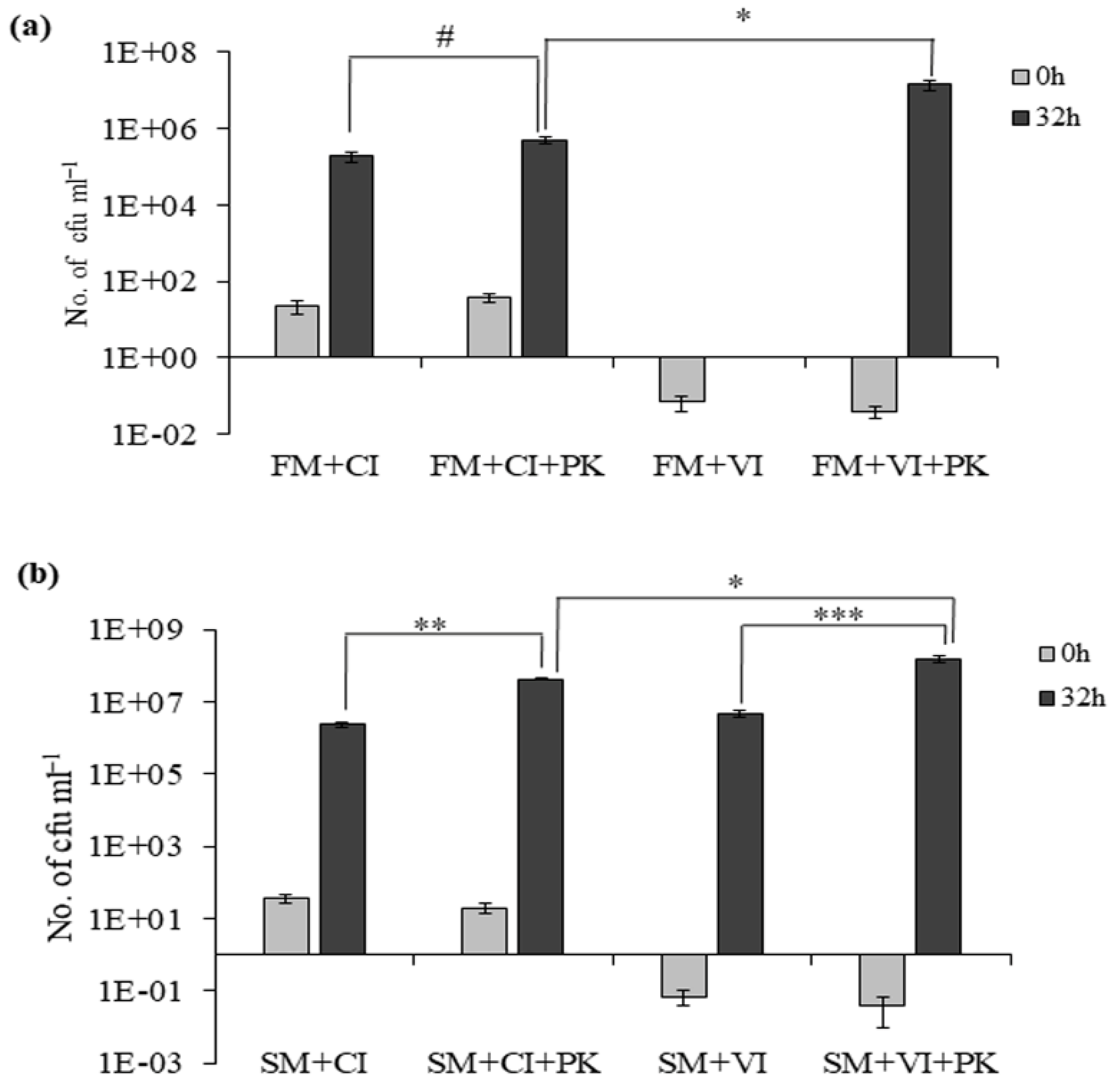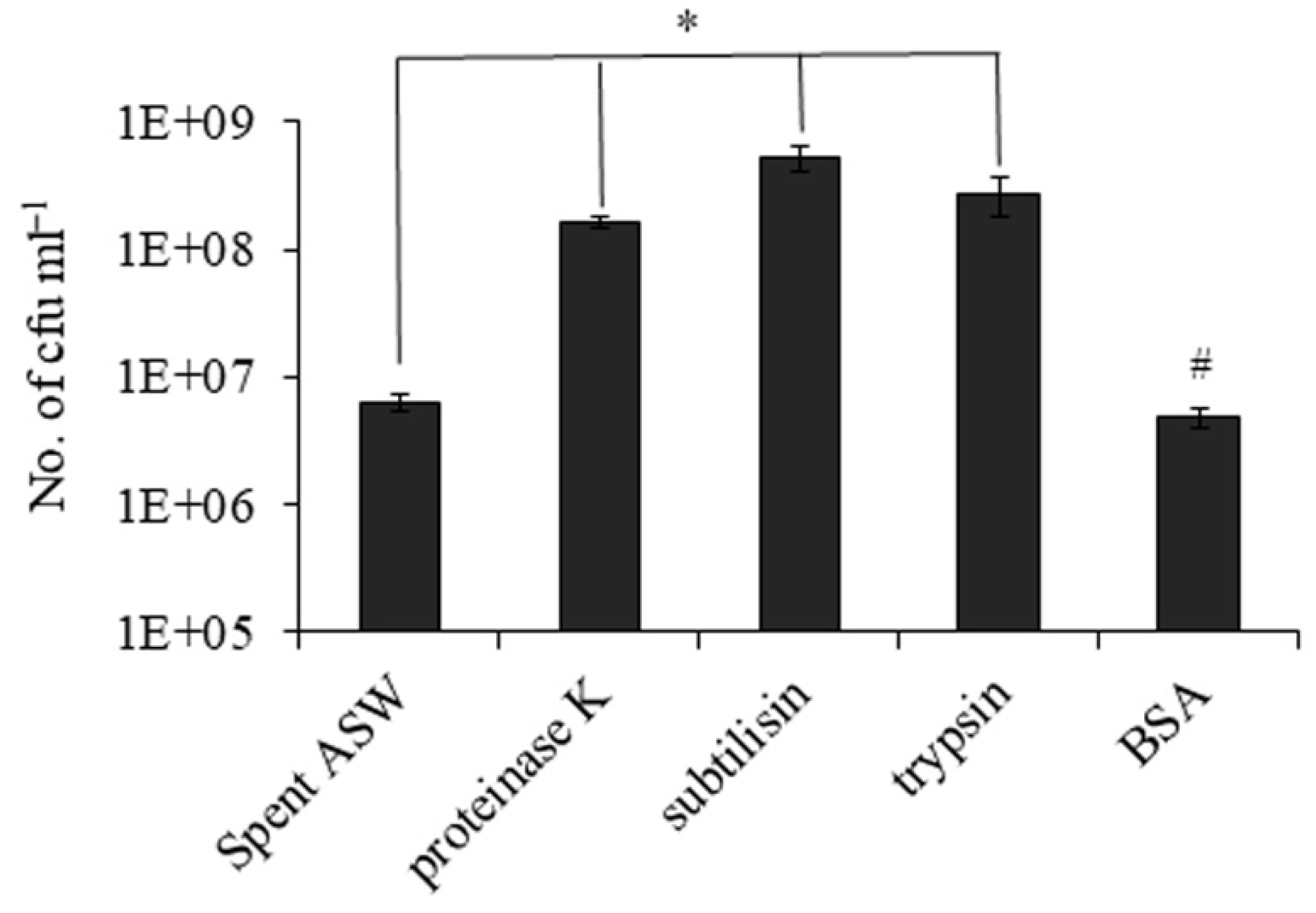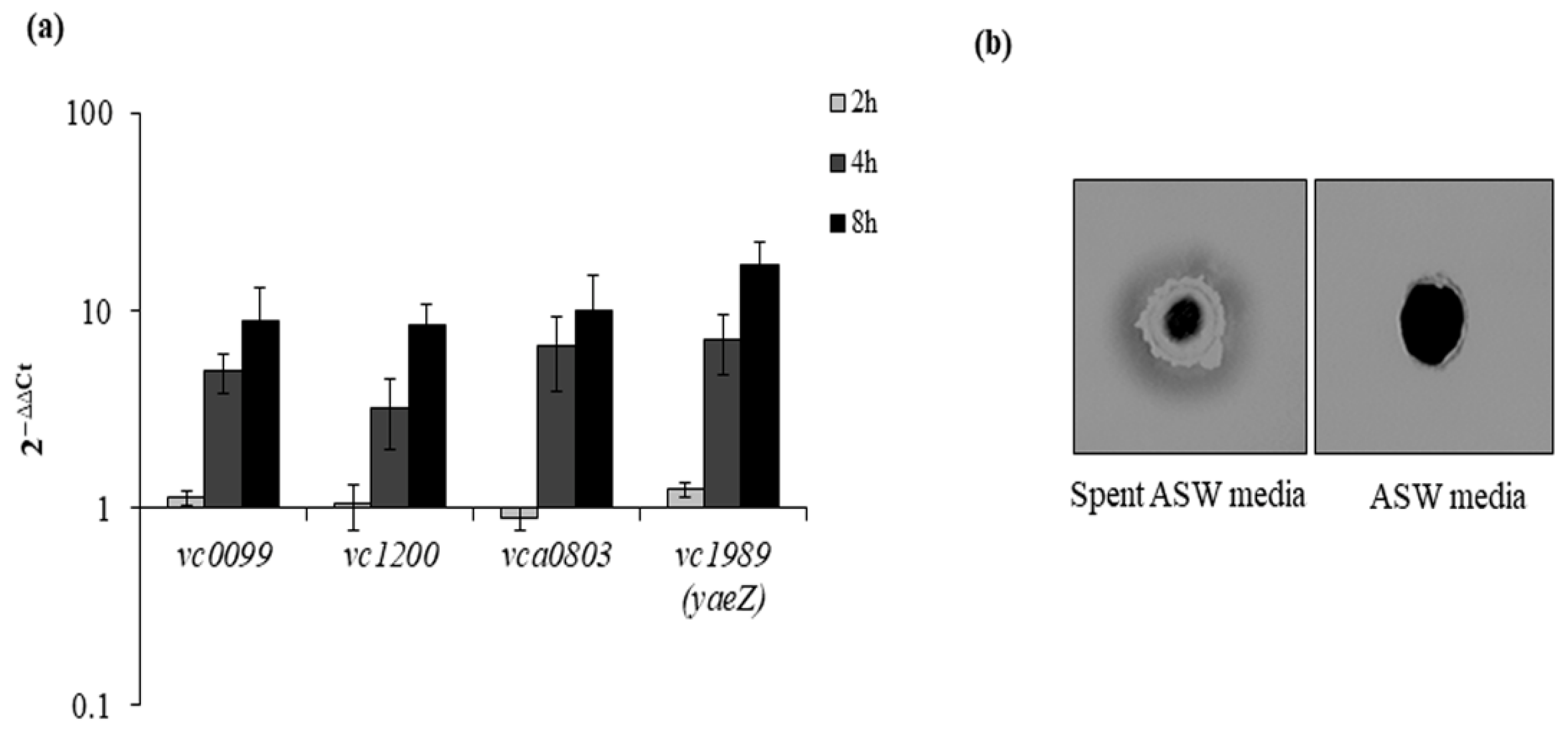The Impact of Protease during Recovery from Viable but Non-Culturable (VBNC) State in Vibrio cholerae
Abstract
1. Introduction
2. Materials and Methods
2.1. Bacterial Strains and Growth Conditions
2.2. Viable but Non Culturable (VBNC) State
2.3. Recovery State
2.4. Culturable State
2.5. Dead Cell Preparation
2.6. Growth in ASW and Spent ASW Media
2.7. RNA Isolation and Real Time RT-PCR
2.8. Skim Milk Plate Assay
2.9. Statistical Analysis
3. Results
3.1. The Effect on Resuscitation Ability of V. cholerae VBNC Cells Either in Heat-Treated or Protease-Supplemented Spent ASW
3.2. Effect of Proteinase K during Recovery of V. cholerae from VBNC State
3.3. Time-Dependent Recovery of VBNC Cells and Growth of Culturable Cells
3.4. Effect of Serine Protease on Recovery of V. cholerae from VBNC State Is a General Trait
3.5. Growth-Promoting Components of Spent ASW Media
3.6. The Recovery State Shows an Increase in Protease Expression
4. Discussion
Supplementary Materials
Author Contributions
Funding
Conflicts of Interest
Abbreviations
| VBNC | viable but non-culturable |
| ASW | artificial sea water |
| FM | ASW media |
| SM | spent ASW media |
| PK | proteinase K |
| FM + PK | proteinase K-supplemented ASW media |
References
- Zhao, X.; Zhong, J.; Wei, C.; Lin, C.W.; Ding, T. Current Perspectives on Viable but Non-culturable State in Foodborne Pathogens. Front. Microbiol. 2017, 8, 580. [Google Scholar] [CrossRef]
- Lattos, A.; Bitchava, K.; Giantsis, I.A.; Theodorou, J.A.; Batargias, C.; Michaelidis, B. The Implication of Vibrio Bacteria in the Winter Mortalities of the Critically Endangered Pinna nobilis. Microorganisms 2021, 9, 922. [Google Scholar] [CrossRef]
- Debnath, A.; Mizuno, T.; Miyoshi, S.I. Comparative proteomic analysis to characterize temperature-induced viable but non-culturable and resuscitation states in Vibrio cholerae. Microbiology (Reading) 2019, 165, 737–746. [Google Scholar] [CrossRef] [PubMed]
- Coutard, F.; Crassous, P.; Droguet, M.; Gobin, E.; Colwell, R.R.; Pommepuy, M.; Hervio-Health, D. Recovery in culture of viable but nonculturable Vibrio parahaemolyticus: Regrowth or resuscitation? ISME J. 2007, 1, 111–120. [Google Scholar] [CrossRef]
- Nilsson, L.; Oliver, J.D.; Kjelleberg, S. Resuscitation of Vibrio vulnificus from the viable but nonculturable state. J. Bacterial. 1991, 173, 5054–5069. [Google Scholar] [CrossRef] [PubMed]
- Whitesides, M.D.; Oliver, J.D. Resuscitation of Vibrio vulnificus from the viable but non culturable state. Appl. Environ. Microbiol. 1997, 63, 1002–1005. [Google Scholar] [CrossRef]
- Ravel, J.; Knight, I.T.; Monahan, C.E.; Hill, R.T.; Colwell, R.R. Temperature-induced recovery of Vibrio cholerae from the viable but nonculturable state: Growth or resuscitation? Microbiology 1995, 141, 377–383. [Google Scholar] [CrossRef][Green Version]
- Liu, Y.; Wang, C.; Tyrrell, G.; Hrudey, S.E.; Li, X.F. Induction of Escherichia coli O157:H7 into the viable but non-culturable state by chloraminated water and river water, and subsequent resuscitation. Environ. Microbiol. Rep. 2009, 1, 155–161. [Google Scholar] [CrossRef] [PubMed]
- Pinto, D.; Almeida, V.; Almeida Santos, M.; Chambel, L. Resuscitation of Escherichia coli VBNC cells depends on a variety of environmental or chemical stimuli. J. Appl. Microbiol. 2011, 110, 1601–1611. [Google Scholar] [CrossRef]
- Morishige, Y.; Fujimori, K.; Amano, F. Differential resuscitative effect of pyruvate and its analogues on VBNC (viable but non-culturable) Salmonella. Microbes. Environ. 2013, 28, 180–186. [Google Scholar] [CrossRef]
- Zeng, B.; Zhao, G.; Cao, X.; Yang, Z.; Wang, C.; Hou, L. Formation and resuscitation of viable but nonculturable Salmonella typhi. Biomed. Res. Int. 2013, 907170. [Google Scholar]
- Morishige, Y.; Koike, A.; Tamura-Ueyama, A.; Amano, F. Induction of Viable but Non culturable Salmonella in Exponentially Grown Cells by Exposure to a Low-Humidity Environment and Their Resuscitation by Catalase. J. Food Prot. 2017, 80, 288–294. [Google Scholar] [CrossRef] [PubMed]
- Senoh, M.; Hamabata, T.; Takeda, Y. A factor converting viable but nonculturable Vibrio cholerae to a culturable state in eukaryotic cells is a human catalase. Microbiologyopen 2015, 4, 589–596. [Google Scholar] [CrossRef] [PubMed]
- Senoh, M.; Ghosh-Banerjee, J.; Ramamurthy, T.; Colwell, R.R.; Miyoshi, S.; Nair, G.B.; Takeda, Y. Conversion of viable but nonculturable enteric bacteria to culturable by co-culture with eukaryotic cells. Microbiol. Immunol. 2012, 56, 342–345. [Google Scholar] [CrossRef]
- Cappelier, J.M.; Besnard, V.; Roche, S.M.; Velge, P.; Federighi, M. Avirulent viable but non culturable cells of Listeria monocytogenes need the presence of an embryo to be recovered in egg yolk and regain virulence after recovery. Vet. Res. 2007, 38, 573–583. [Google Scholar] [CrossRef]
- Guillou, S.; Leguerinel, I.; Garrec, N.; Renard, M.A.; Cappelier, J.M.; Federighi, M. Survival of Campylobacter jejuni in mineral bottled water according to difference in mineral content: Application of the Weibull model. Water Res. 2008, 42, 2213–2219. [Google Scholar] [CrossRef] [PubMed][Green Version]
- Kana, B.D.; Mizrahi, V. Resuscitation-promoting factors as lytic enzymes for bacterial growth and signaling. FEMS Immunol. Med. Microbiol. 2010, 58, 39–50. [Google Scholar] [CrossRef] [PubMed]
- Rosser, A.; Stover, C.; Pareek, M.; Mukamolova, G.V. Resuscitation-promoting factors are important determinants of the pathophysiology in Mycobacterium tuberculosis infection. Crit. Rev. Microbiol. 2017, 43, 621–630. [Google Scholar] [CrossRef]
- Panutdaporn, N.; Kawamoto, K.; Asakura, H.; Makino, S.I. Resuscitation of the viable but non-culturable state of Salmonella enterica serovar Oranienburg by recombinant resuscitation-promoting factor derived from Salmonella Typhimurium strain LT2. Int. J. Food Microbiol. 2006, 106, 241–247. [Google Scholar] [CrossRef]
- Handford, J.I.; Ize, B.; Buchanan, G.; Butland, G.P.; Greenblatt, J.; Emili, A.; Palmer, T. Conserved network of proteins essential for bacterial viability. J. Bacteriol. 2009, 191, 4732–4749. [Google Scholar] [CrossRef]
- Aydin, I.; Saijo-Hamano, Y.; Namba, K.; Thomas, C.; Roujeinikova, A. Structural analysis of the essential resuscitation promoting factor YeaZ suggests amechanism of nucleotide regulation through dimer reorganization. PLoS ONE 2011, 6, e23245. [Google Scholar] [CrossRef]
- Zhao, R.; Chen, J.; Wang, Y.; Li, Y.; Kong, X.; Han, Y. Proteolytic activity of Vibrio harveyi YeaZ is related with resuscitation on the viable but non-culturable state. Lett. Appl. Microbiol. 2020, 71, 126–133. [Google Scholar] [CrossRef]
- Pascoe, B.; Dams, L.; Wilkinson, T.S.; Harris, L.G.; Bodger, O.; Mack, D.; Davies, A.P. Dormant cells of Staphylococcus aureus are resuscitated by spent culture supernatant. PLoS ONE 2014, 9, e85998. [Google Scholar] [CrossRef]
- Asakura, H.; Ishiwa, A.; Arakawa, E.; Makino, S.; Okada, Y.; Yamamoto, S.; Igimi, S. Gene expression profile of Vibrio cholerae in the cold-stress induced viable but non-culturable state. Environ. Microbiol. 2006, 9, 869–879. [Google Scholar] [CrossRef] [PubMed]
- Wong, H.C.; Wang, P. Induction of viable but nonculturable state in Vibrio parahaemolyticus and its susceptibility to environmental stresses. J. Appl. Microbiol. 2004, 96, 359–366. [Google Scholar] [CrossRef] [PubMed]
- Keep, N.H.; Ward, J.M.; Cohen-Gonsaud, M.; Henderson, B. Wake up! Peptidoglycan lysis and bacterial non-growth states. Trends Microbiol. 2006, 14, 271–276. [Google Scholar] [CrossRef]
- Li, Y.; Chen, J.; Zhao, M.; Yang, Z.; Yue, L.; Zhang, X. Promoting resuscitation of viable but nonculturable cells of Vibrio harveyi by a resuscitation-promoting factor-like protein YeaZ. J. Appl. Microbiol. 2017, 122, 338–346. [Google Scholar] [CrossRef]
- McDonough, E.; Kamp, H.; Camilli, A. Vibrio cholerae phosphatases required for the utilization of nucleotides and extracellular DNA as phosphate sources. Mol. Microbiol. 2016, 99, 453–469. [Google Scholar] [CrossRef]
- Takano, S.; Pawlowska, B.J.; Gudelj, I.; Yomo, T.; Tsuru, S. Density-Dependent Recycling Promotes the Long-Term Survival of Bacterial Populations during Periods of Starvation. mBio 2017, 8, e02336-16. [Google Scholar] [CrossRef] [PubMed]
- Lehman, M.K.; Nuxoll, A.S.; Yamada, K.J.; Kielian, T.; Carson, S.D.; Fey, P.D. Protease-mediated growth of Staphylococcus aureus on host proteins is opp3 dependent. mBio 2019, 10, e02553-18. [Google Scholar] [CrossRef]
- Su, X.; Shen, H.; Yao, X.; Ding, L.; Yu, C.; Shen, C. A novel approach to stimulate the biphenyl-degrading potential of bacterial community from PCBs-contaminated soil of e-waste recycling sites. Bioresour. Technol. 2013, 146, 27–34. [Google Scholar] [CrossRef] [PubMed]
- Mu, D.-S.; Liang, Q.-Y.; Wang, X.-M.; Lu, D.-C.; Shi, M.-J.; Chen, G.-J.; Du, Z.-J. Metatranscriptomic and comparative genomic insights into resuscitation mechanisms during enrichment culturing. Microbiome 2018, 6, 230. [Google Scholar] [CrossRef] [PubMed]






| Sample | Recovered cfu mL−1 |
|---|---|
| Undiluted VBNC | 6 × 106 |
| 10-fold diluted VBNC in spent ASW media | 4.9 × 106 |
| 10-fold diluted VBNC in heat treated spent ASW media | No recovery |
| 10-fold diluted VBNC in spent ASW supplemented with Proteinase K | 1.58 × 108 |
Publisher’s Note: MDPI stays neutral with regard to jurisdictional claims in published maps and institutional affiliations. |
© 2021 by the authors. Licensee MDPI, Basel, Switzerland. This article is an open access article distributed under the terms and conditions of the Creative Commons Attribution (CC BY) license (https://creativecommons.org/licenses/by/4.0/).
Share and Cite
Debnath, A.; Miyoshi, S.-i. The Impact of Protease during Recovery from Viable but Non-Culturable (VBNC) State in Vibrio cholerae. Microorganisms 2021, 9, 2618. https://doi.org/10.3390/microorganisms9122618
Debnath A, Miyoshi S-i. The Impact of Protease during Recovery from Viable but Non-Culturable (VBNC) State in Vibrio cholerae. Microorganisms. 2021; 9(12):2618. https://doi.org/10.3390/microorganisms9122618
Chicago/Turabian StyleDebnath, Anusuya, and Shin-ichi Miyoshi. 2021. "The Impact of Protease during Recovery from Viable but Non-Culturable (VBNC) State in Vibrio cholerae" Microorganisms 9, no. 12: 2618. https://doi.org/10.3390/microorganisms9122618
APA StyleDebnath, A., & Miyoshi, S.-i. (2021). The Impact of Protease during Recovery from Viable but Non-Culturable (VBNC) State in Vibrio cholerae. Microorganisms, 9(12), 2618. https://doi.org/10.3390/microorganisms9122618





